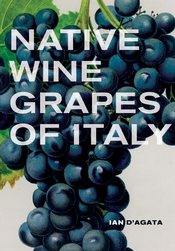When a copy of Ian d’Agata’s “Native Wine Grapes of Italy” landed on my desk with a thud, I glanced at the title and then did a double-take. Could it be that there are enough “native” wine grapes in Italy to fill more than 600 pages? Well, yes, as I discovered by looking at the long list of Native Grapes by Region in the front of the book.
Yet, there was something odd about the title. Then I remembered that as an American wine consumer, the phrase “native wine grapes” usually means grapes native to North America that  are sometimes used to make wine. The wine grapes we know and love in their vinous form (Chardonnay, Cabernet Sauvignon, etc.) are from the genus and species Vitis vinifera and are not native to North America.
are sometimes used to make wine. The wine grapes we know and love in their vinous form (Chardonnay, Cabernet Sauvignon, etc.) are from the genus and species Vitis vinifera and are not native to North America.
I have been drinking Italian wines for decades and, as a writer, was familiar with such major grapes as Nebbiolo, Sangiovese and Arneis, but the fact that–as Ian d’Agata discovered over 13 years traveling up and down the Italian peninsula–there are more than 500 different Italian native grape varieties left me gobsmacked.
Ian d’Agata is a Rome-based wine writer who specializes in Italian and French wines. He is, to put it bluntly, obsessive about the “What, Where, When, Why and How” of native Italian grapes. Those four “w’s” (plus the “How”) are the basics that every journalist learns to ask when writing a story. D’Agata thoroughly covers them in the first 50 pages (Part I), along with an interesting essay on “Ampelology” and a second essay on “The Origin of Viticulture and a Brief History of Grape Varieties.” The short treatise on the history of grape varieties is, by far, the most interesting. But in “Ampelology,” d’Agata relishes picking a little nit. He recounts an occasion when he was stopped in “mid-conversation” by the persnickety head winemaker for J.P. Moueix, for using the incorrect term, ampelography, when d’Agata should have said ampelology. The author provides a lengthy explanation of the differences between the two terms that is worth reading–if splitting semantic hairs interests you.
In Part II, d’Agata gets down to business with an exhaustive list of native and traditional grape varieties, divided by Grape Groups and Families, Major Native and Traditional Grape Varieties, Little-Known Native and Traditional Grape Varieties and Crossings. In the short introduction to Chapter Four, “Major Native and Traditional Grape Varieties,” the author explains that the grapes listed are “major” because “practically all are listed in the National Registry…are generally recognized as the country’s best known… and (are) sold to the public by at least one estate.” Who knew that Abrostine, Bovale Sardo, Famoso di Pesaro, Nasco and Vitovska are among Italy’s best-known wine grapes?
But d’Agata is not finished with his lists. Following the comprehensive tally of “major” grapes, the author adds a shorter list of little-known grapes. He defines scores of wine grapes, from Abbuoto to Zanello, in Chapter Five, but curiously includes Rondinella, a variety known to wine fans of Valpolicella and Amarone. D’Agata’s reason for not granting “major” status to Rondinella, which earlier in Chapter Four, he calls a “famous cultivar”: “Nobody uses it to make a monovarietal wine in Italy.”
Okay, I’m indulging in a little nit picking here myself. The fact is that the author is to be commended for his diligence and hard work. “Native Wine Grapes of Italy” is an impressive labor of love. Still, I wonder how many American wine drinkers, except maybe for academics and Italian wine specialists, are going to fork over $50 for a book containing so many wine grapes that they are never likely to encounter, short of spending 13 years, as D’Agata did, scouring the length and breadth or Italy.
I once knew a New York-based wine writer who had an encyclopedic knowledge of Bordeaux wines, but also some unorthodox theories of when best to drink them. He was stubbornly insistent that his theories on how long to aerate a wine were correct, while at the same time, he was an intriguing font of knowledge who often was difficult to ignore. In “Native Wine Grapes of Italy,” Ian d’Agata shows the qualities of a learned researcher and an entertaining writer who knows how to spin a tale or two. And while this text is not a casual summer read, it is recommended, with the above caveat on price, as an essential addition to the well-stocked library of all Italian wine fans.
Native Wine Grapes of Italy, Ian d’Agata, University of California Press, 620 pages, hardcover, $50, ISBN: 9780520957053
WRO Columnist Emeritus Gerald Boyd regularly reviews wine books in this space, writing from his so-called “retirement.”
6
